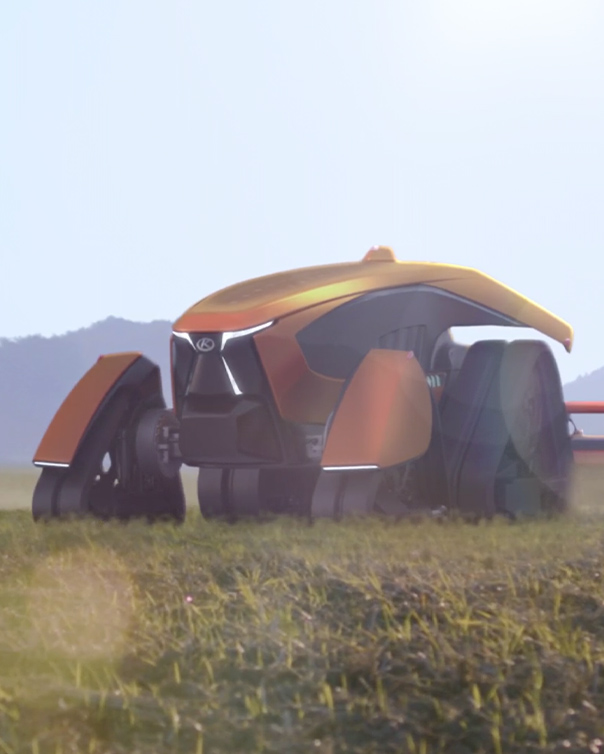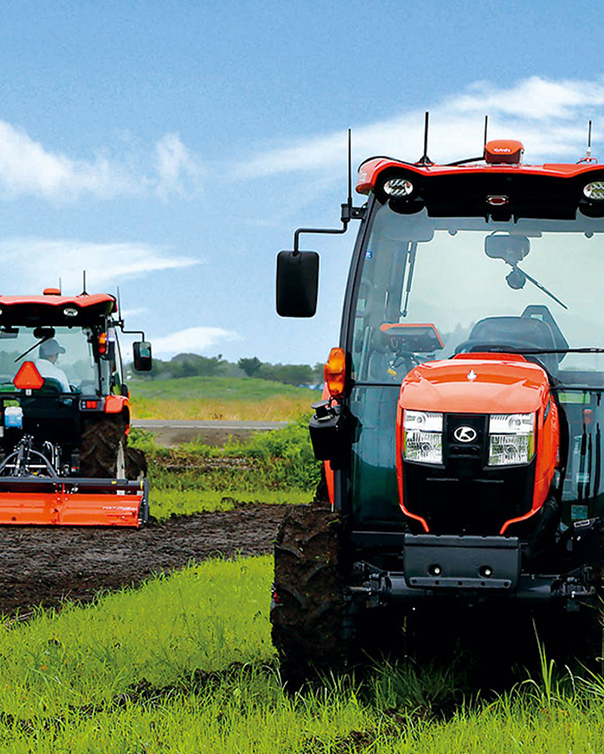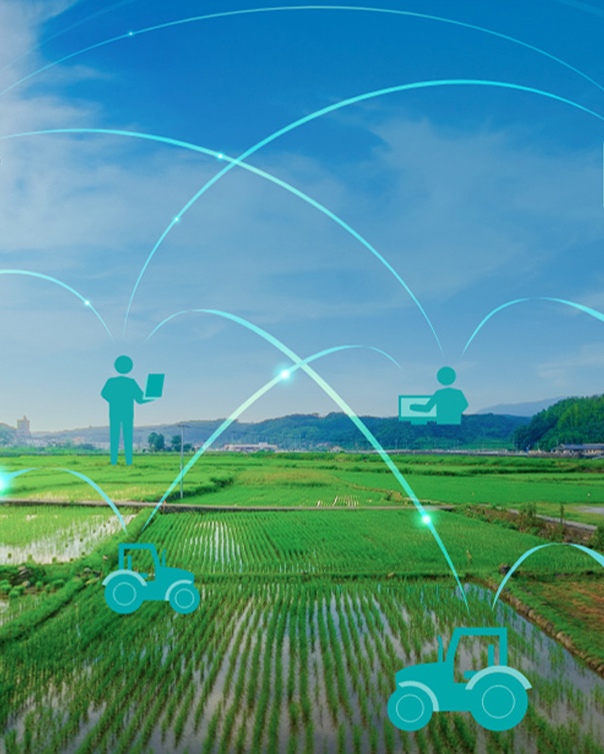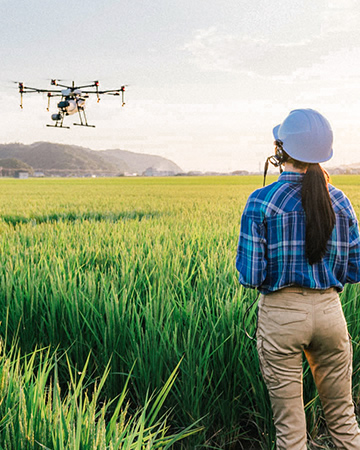
The “Kubota New Year Session” is held in January each year. The purpose of the event is to express gratitude to the people supporting Kubota, to present our business vision and to introduce new products and services to them. The gathering this year coincided with Kubota’s 130th anniversary and a particularly special exhibit was shown.
That exhibit was the “130th Anniversary Dream Tractor.”
Ever since its establishment, Kubota has developed its business with the mission of “solving the problems in society.” In the food sector in particular, Kubota has drawn up its ideal image of what agriculture should be in Japan and has considered the issues for farmers while developing the products and services required in each era. As we reach the 130th anniversary of the company, the issues in the areas of “food, water, and the environment” are becoming more interconnected than ever before. It is therefore becoming necessary to take an even more integrated approach to tackling them.
“Social Agri” is the future vision of agriculture in a sustainable society that Kubota is aiming for. The concept tractor announced this time indicates one of the directions Kubota is pursuing in technical development for that aim.
Kubota will use agriculture as a starting point to tackle the issues that have mutual crossover in the areas of “food, water, and the environment.”
What is Kubota’s mission in technical development for agriculture?
At first glance, the concept tractor does not look like the design of a tractor. It looks more like a robot anime mecha, or a vehicle from an SF movie. The design offers completely human-free autonomous driving and also strives to be gentle on the environment with full electrification, so there is no cabin (driver’s seat) and no refueling port.
However, Kubota is not merely trying to communicate the outward appearance and functional concepts of the tractor, but also the “Hopes for the future” that Kubota is aiming for.

Imagine one day in early summer, when the winter fallow season for the rice fields is ending and the time to plow is approaching.
A concept tractor connected to its charging base quietly starts up.
Before it starts to move, it first accesses the maps registered for the land to be cultivated and the weather forecast data. At the same time, it also sends out commands to a drone to sense the up-to-date condition of the fields. It then formulates a work plan.

When that plan is approved by the farm manager, the concept tractor starts to move.
It continues to work with absolutely no need for human labor. It proceeds with the work while communicating and coordinating with other farm machinery and systems connected to the same network. It steadily completes all the work necessary with perfect timing. This includes all the work necessary up to harvesting, from tilling, plowing and irrigating to the transplanting of rice seedlings, making ridges, adding fertilizer and spraying pesticides.
The farm managers can use a smartphone or other device at any time to check the reports on the status of the work and the fields that the tractor sends out.

This work has previously relied on intuition that is honed over many years. However, it will be managed and planned based on various different data and will be advanced by AI learning. Agricultural work will be promoted in a planned manner with surprising accuracy and it will be possible to operate the machinery remotely.
Kubota has been working towards the realization of “Smart agriculture” for some time and is ahead of the industry in the “automation” that will be the key for extreme labor-saving and extremely high precision. This technology development has been promoted with products such as the autonomous “Agri Robo Tractor” launched in 2017.
However, the future image of “Social Agri” that Kubota is aiming for is not limited to the realization of “agriculture that requires no labor.”
Agriculture in Japan is currently facing the challenges posed by the declining size of the working population and the aging of the agricultural workforce.
At the same time, people are viewing food in different ways. Through the period of post-war recovery and high economic growth, people found satisfaction in being able to eat until they were full. However, the times changed and people started to demand “even more delicious items” and then “safety and reassurance.” Requirements for “functionality” such as nutrients are now becoming more prominent and our demands on our “food” continue to become increasingly sophisticated.
We are also now in a time when the sustainability of our food production is being questioned. We must comprehensively consider the “environment” in aspects such as the securing and use of “water” for agricultural work.
We must face these labor related issues and changing consumer requirements and continue to produce higher value crops. To achieve this, Kubota needs to continue supporting advances in the technology used in agriculture. Then, with agriculture as a starting point, Kubota must aim to realize a better society and to increase the attraction of agriculture. This is why Kubota believes that it should pursue technology development in agriculture.
Creating new value by crossing “human hopes” with “technology.”
This concept tractor expresses Kubota’s approach of creating new innovation for the future by “combining and merging” the various technology and experience within the company and pursuing “collaboration” with external technologies and customer needs. This illustrates how Kubota aims to create new value for the future.

Recent technical progress has led to the replacement of conventional work with technology. At the same time, the role that should be fulfilled by human beings is moving into more creative areas. In agriculture too, the “vision and meaning of agriculture” imagined by each individual producer will probably become increasingly important.
The “hopes” of producers and managers include “What kind of agriculture do we want to do?” “What crops do we want to produce?” and thoughts such as “We want to protect the rich natural environment.” These “hopes” cannot be created by machinery or AI. Furthermore, without these “hopes,” there would be no creation of technology.
In 1970, Kubota exhibited the “Dream Tractor Talent 25” in the Kubota Pavilion at the Japan World Exposition held in Osaka. That tractor brought together the technology of the time to offer superior functionality, fully air-conditioned comfort, safety and easy operability. During the 50 years from 1970 to 2020, many of the “hopes” of that time have been realized through the development of various technologies. This includes the hope for comfort in agricultural work, which was realized with the comfort and safety achieved by mounting a cabin. There were also improvements to operability achieved through advances made in various hydraulic mechanisms.

The Dream Tractor exhibited in 1970 in the Kubota Pavilion at the Osaka Expo

Osaka Expo “Kubota Pavilion”
The “130th anniversary Dream Tractor” was presented to indicate one of the directions that the technical development by Kubota will take to achieve the company’s “Hopes for the future.” Kubota strives to ensure that this announcement provokes even more “hopes for the future of agriculture and society” and works to “combine” and “merge” those many hopes and pursues “collaboration” for the creation of innovation.




